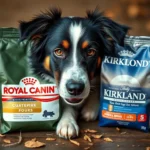
Introduction
Dog nutrition is fundamental to a dog’s overall health, influencing everything from energy levels to coat quality. Just like humans, dogs require a balanced diet that meets their specific nutritional needs. One popular protein source that has gained traction in the pet food industry is lamb. This article will delve into the best lamb dog foods, exploring their benefits, nutritional profile, and how to choose the right one for your furry friend.
Understanding Dog Nutrition
Basic Nutritional Needs of Dogs
To understand the best lamb dog foods, it’s essential first to grasp the basic nutritional needs of dogs. Dogs need a balanced diet composed of three primary macronutrients:
- Proteins: The building blocks for growth, tissue repair, and overall health.
- Fats: A vital energy source, essential fatty acids support skin health and coat quality.
- Carbohydrates: They provide energy and aid digestion but should be balanced with proteins and fats.
In addition to macronutrients, dogs require a variety of vitamins and minerals to maintain optimal health. These nutrients support various bodily functions, including immune response, bone health, and metabolic processes.
Role of Protein in Dog Diet
Protein plays a crucial role in a dog’s diet. It is essential for:
- Growth and Maintenance: Puppies, adults, and senior dogs all have different protein needs, but all require protein to maintain muscle mass and overall health.
- Energy: Proteins can serve as an energy source, especially in active breeds.
- Immune Function: Proteins help in the production of antibodies that defend against disease.
When comparing protein sources, animal-based proteins, like lamb, are often considered superior to plant-based proteins due to their complete amino acid profiles, which closely match a dog’s dietary needs.
Benefits of Lamb as a Protein Source
Lamb is a highly nutritious protein source, offering several benefits:
- Nutritional Profile: Rich in high-quality protein, vitamins (such as B12 and niacin), and minerals (like zinc and iron), lamb helps support a dog’s overall health.
- Hypoallergenic Properties: Lamb is less commonly used in dog foods than other meats, making it a suitable choice for dogs with food sensitivities or allergies.
Factors to Consider When Choosing Dog Food
Ingredients Quality
The quality of ingredients is paramount when selecting dog food. Look for whole, natural ingredients without fillers or artificial additives. Understanding the difference between meat meal and whole meat can also be beneficial. Meat meal is a concentrated source of protein, while whole meat contains moisture, which can dilute the protein content.
Life Stage Appropriateness
Dogs’ nutritional requirements change as they age. Puppies need diets rich in proteins and fats for growth, while adult and senior dogs require diets that maintain health without excessive calories. Always choose a food appropriate for your dog’s life stage to ensure they get the right balance of nutrients.
Special Dietary Needs
Consider any specific dietary needs your dog may have. Dogs with allergies or sensitivities may benefit from limited ingredient diets that focus on a single protein source, like lamb. Additionally, dogs with health conditions may require specific dietary adjustments.
Brand Reputation and Certifications
When selecting dog food, prioritize reputable brands with positive reviews and industry certifications. Brands that undergo regular quality testing and have a history of transparency with their ingredient sourcing are typically more reliable.
Top Picks for Best Lamb Dog Foods
Overview of Criteria for Selection
To curate this list of the best lamb dog foods, we evaluated each product based on the following criteria:
- Quality of ingredients
- Nutritional content
- Brand reputation
- Customer reviews
Detailed Reviews of Top Lamb Dog Foods
Brand A: Blue Buffalo Life Protection Formula Lamb & Brown Rice Recipe
- Key Features and Benefits: This food contains real lamb as the first ingredient and is enriched with whole grains, fruits, and vegetables, making it a well-rounded option for adult dogs.
- Nutritional Breakdown: Approximately 20% protein, 8% fat, and 4% fiber.
- Customer Reviews and Ratings: Highly rated for its quality ingredients and palatability. Many customers report improved coat health and energy levels in their dogs.
Brand B: Wellness CORE Grain-Free Lamb Recipe
- Key Features and Benefits: This grain-free formula focuses on high-protein content, featuring lamb and lamb meal as primary ingredients, making it ideal for active dogs.
- Nutritional Breakdown: Roughly 34% protein, 15% fat, and 5% fiber.
- Customer Reviews and Ratings: Customers appreciate the absence of fillers and report their dogs thriving on this diet.
Brand C: Natural Balance L.I.D. Limited Ingredient Diets Lamb & Brown Rice Formula
- Key Features and Benefits: Specifically designed for dogs with food sensitivities, this limited ingredient diet uses lamb as the single animal protein source.
- Nutritional Breakdown: Contains around 20% protein, 8% fat, and 4% fiber.
- Customer Reviews and Ratings: Positive feedback for reducing allergy symptoms and digestive issues in sensitive dogs.
Brand D: Merrick Grain-Free Texas Beef & Lamb Recipe
- Key Features and Benefits: Combines both beef and lamb, providing a unique protein blend. This grain-free formula also includes a variety of fruits and vegetables for added nutrition.
- Nutritional Breakdown: Approximately 38% protein, 16% fat, and 4% fiber.
- Customer Reviews and Ratings: Highly rated for its taste; many owners noted their dogs eagerly devour this food.
Brand E: NUTRO Limited Ingredient Diet Adult Lamb & Sweet Potato Recipe
- Key Features and Benefits: This formula contains real lamb and sweet potatoes, focusing on the needs of dogs with food sensitivities.
- Nutritional Breakdown: About 21% protein, 14% fat, and 4% fiber.
- Customer Reviews and Ratings: Well-reviewed for its digestibility and effectiveness in managing allergies.
Homemade Lamb Dog Food Recipes
Benefits of Homemade Dog Food
Preparing homemade dog food can be a rewarding endeavor. It allows pet owners to control the quality of ingredients and tailor meals specifically to their dog’s needs. However, it’s essential to weigh the pros and cons, such as ensuring nutritional balance and the time commitment required.
Simple Lamb Dog Food Recipe
Ingredients List
- 2 lbs of ground lamb
- 1 cup of brown rice
- 1 cup of carrots, diced
- 1 cup of peas, frozen or fresh
- 1/2 cup of pumpkin puree (not the spiced pie filling)
- 2 cups of water
Step-by-Step Preparation Instructions
- In a large pot, combine the ground lamb and water. Cook over medium heat until the lamb is browned.
- Add the brown rice, carrots, and peas. Stir to combine.
- Cover and simmer for about 20 minutes or until the rice is fully cooked.
- Stir in the pumpkin puree and allow it to cool before serving.
- Store leftovers in the refrigerator for up to five days.
Nutritional Considerations for Homemade Diets
While homemade diets can be beneficial, ensuring a balanced diet is crucial. Consider consulting with a veterinarian or a pet nutritionist to determine the appropriate vitamins, minerals, and supplements your dog may need to maintain optimal health.
Transitioning to Lamb Dog Food
How to Transition Your Dog’s Diet Safely
When introducing new food to your dog, it’s important to do so gradually. A general guideline is to follow a 7-10 day transition plan:
- Days 1-2: Mix 25% new lamb food with 75% of the current food.
- Days 3-4: Mix 50% new food with 50% current food.
- Days 5-6: Mix 75% new food with 25% current food.
- Day 7: Serve 100% new lamb food.
This gradual transition helps prevent digestive upset.
Signs of Food Sensitivity or Allergies
When switching diets, monitor your dog for any signs of food sensitivity or allergies, such as:
- Gastrointestinal issues (vomiting, diarrhea)
- Skin irritations or excessive itching
- Changes in behavior (lethargy, restlessness)
If any symptoms arise, consult with your veterinarian for further guidance.
Conclusion
Quality dog nutrition is vital for maintaining your dog’s health and well-being. The best lamb dog foods provide excellent protein sources, catering to various dietary needs, including those with sensitivities. Always consult with a veterinarian for personalized dietary recommendations tailored to your dog’s specific needs.
In summary, choosing the right lamb dog food can enhance your dog’s quality of life, making it essential to understand their nutritional requirements and preferences. With the right information and resources, you can ensure your furry friend is happy and healthy.









